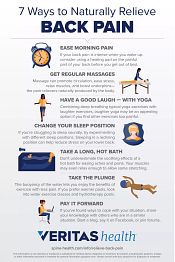



However, if you experience back pain together with any of the following symptoms, visit your GP as soon as possible: The majority of cases of back pain usually clear up quite quickly. The symptom of lower back pain is a pain or ache anywhere on your back, in between the bottom of the ribs and the top of the legs. For example, pain that is caused by some types of arthritis may be treated using specific medicines. Treatment for back pain will usually depend on the underlying cause of the condition. However, in severe and persistent cases of back pain, it is important to seek medical advice so that a correct diagnosis can be reached and appropriate treatment given. Pain that lasts longer usually clears up after about six weeks. Back pain will usually last from a few days to a few weeks. In most cases of back pain your back will heal itself, and staying active and continuing with your usual activities will normally promote healing. This is known as sciatica (go to ‘Useful links’ for more information). In some cases, if a nerve in your back is pinched or irritated, the pain can spread to your buttocks and thighs. Pain in your lower back is usually a symptom of stress or damage to your ligaments, muscles, tendons or discs. The complex structure of your lower back means that even small amounts of damage to any part of the lumbar region can cause a lot of pain and discomfort. Lower back pain can come on suddenly or gradually, and is sometimes the direct result of a fall or injury. Lower back pain is a pain or ache on your back, in between the bottom of your ribs and the top of your legs. Lower back pain, also known as lumbago, affects seven out of 10 people at some time in their lives. The lumbar supports the entire weight of your upper body (plus any extra weight that you are carrying), and it is under constant pressure, particularly when you are bending, twisting and lifting. The lower part of your back is known as the lumbar region, which is made up of five vertebrae, known as L1, L2, 元, L4 and L5.


 0 kommentar(er)
0 kommentar(er)
